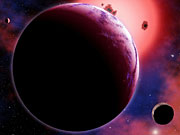- Number 357 |
- February 27, 2012
Out of this world

The planet GJ 1214b, shown
here in an artist's conception
with
two hypothetical moons,
orbits a "red dwarf" star
40 light-years
away from Earth.
Image credit:
Center for
Astrophysics/David Aguilar.
Using models similar to those used in weapons research, Lawrence Livermore scientists may soon know more about exoplanets, those objects beyond the realm of our solar system.
In a new study, scientists at DOE's Lawrence Livermore National Laboratory and collaborators came up with new methods for deriving and testing the equation of state (EOS) of matter in exoplanets and figured out the mass-radius and mass-pressure relations for materials relevant to planetary interiors.
Astronomers started detecting exoplanets 18 years ago and more than 700 have been found so far, the vast majority within the last two years. Interest is now growing in the structure and atmospheres of these worlds.
New equation-of-state work helps interpret the structure of exoplanets. As there is a minimal amount of data in each exoplanet observation, interpretation of their composition and structure depends largely on comparing their mass and radius with the composition expected given the distance from their parent star. The makeup implies a mass-radius relation, which relies heavily on EOS calculated from electronic structure theory and measured experimentally on Earth.
In the new research, led by Laboratory scientist Damian Swift, along with LLNL colleagues Jon Eggert, Damien Hicks, Sebastien Hamel, Kyle Caspersen, Eric Schwegler and Rip Collins, compared their modeling results with the observed masses and radii of exoplanets. Their results broadly support recent assumptions about the structures of exoplanets but can now take advantage of the accurate EOS models and data produced at Livermore.[Anne M. Stark, 925.422.9799,
stark8@llnl.gov]
